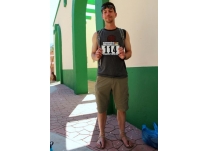Caballo Blanco's Legacy Lives On: Tom Norwood Returns from Copper Canyon
In my recent interview with Tim Norwood, sales monkey for Luna Sandals, I spoke to him as he was heading down to Mexico with Barefoot Ted to run the 50-mile Ultramarathon Caballo Blanco.
The race, formerly called the Copper Canyon Ultramarathon, was made famous by Christopher McDougall's book Born to Run. The book documented Caballo Blanco's efforts to create an endurance race that allowed outsiders to run alongside the Tarahumara on their own turf without disturbing their culture. The ultramarathon was renamed after Caballo's unexpected passing in 2012. This year, over 500 runners participated.
I caught up with Tom after he returned to the US to hear about his experiences with the race and the community it embraces. He provided all the photos in this post, which were taken on location.
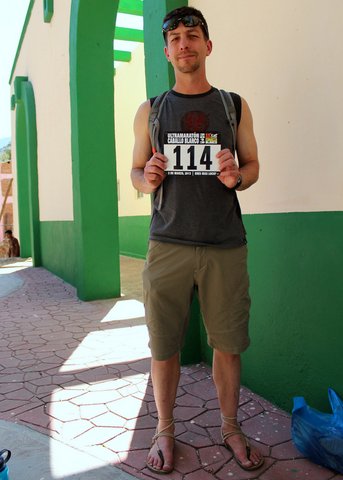
Tom Norwood picking up his bib number for the Ultramarathon Caballo Blanco
EM: Welcome back Tom! Let's jump right into it. Did you finish the race?
TN: Well… I did, but it was kind of touch and go. I wasn't concerned about my time, I just wanted to finish. I didn't finish in the official 14 hour cutoff, but they extended the time so I sort of made it.
EM: I know you were concerned about running in the heat. How bad was it?
TN: Brutal. Definitely the hard part. At mile 25, in the heat of the day, my body and my stomach just shut down. I was barely able to take in food or liquid. At the mile 31 aid station, I ate two handmade tortillas with salt and a grapefruit. That was the last solid food I ate the whole race. Around that time, Luis Escobar [the runner and photographer from Born to Run who documented the first race] saw me and I looked terrible. He shoved electrolytes and a Jolly Rancher into my mouth and said encouraging things.
I was having trouble. Anytime I tried to exert myself uphill I felt horrible. For a while, I tried powerwalking so I could make the time limit, but I couldn't keep it up. Back through mile 40, I knew I wouldn't make it in time so I sat down. When Louis saw me there, he ran over to check up on me. I told him I wanted to finish so badly. He said all I could do was to drink micro sips of water, lie down and in 10 minutes I'd feel better. I told him I'm not going to make the time cutoff if I did that and he said, "This is Mexico. What are you afraid they're going to do?"
Then he took off his yellow bandana buff and told me he wore it both times he ran Badwater, the seven times he ran Western States and the time he ran and won the Hurt-100. He put it on my head and said "There's no way you won't finish if you're wearing this." Then Bookis, the CEO of Luna Sandals, started pacing me. I took micro-sips of peach nectar, but vomited it all up at mile 44. At least, I thought all if it came up, but I vomited more at the mile 46 turnaround. Then I dry heaved, which showed there really was nothing left in me.
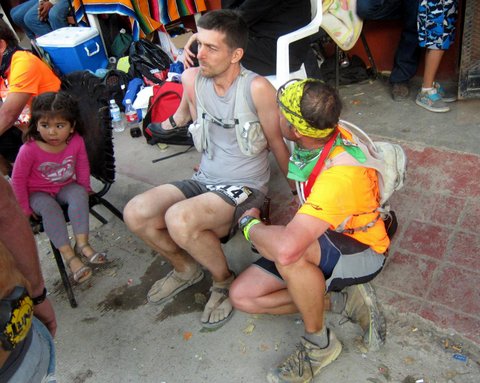
Tom sitting with Luis Escobar
It was pitch dark, and the most beautiful sky I ever saw. The stars looked amazing. I finally came back to town and everyone was waiting for me. When I finished, they all threw their arms around me. It was discouraging to finish so slow—I think only three people came in behind me—but it was my friends who made it possible for me to get through it. It was an incredible experience.
EM: How did you feel the next day?
TN: I felt fine. I finished the race late, around 10pm, so I lay down. On the way back to the hostel I bought a Coke but could drink only two sips of it. I went to sleep and woke up at 4am, wide awake. At the hostel we were in, there were about fifty people and only two showers. It was normally hard to get a shower without waiting, but I knew I could take one at that time. I did and it felt amazing.
We left the next day, and during lunch before the train ride my fingers kept cramping while I was trying to eat. They kept twisting in different directions. I added salt to my food and forced them back into place. It had something to do with extreme dehydration and lack of electrolytes. The day after that I was fine, though. I went to the beach and skateboarded and everything was great.
EM: How did the new Luna Oso sandals hold up?
TN: They were great, man. The whole time I thought "these are perfect." I did feel some pain in one foot on a long downhill, like a pressure between the toes, but at the mile 20 aid station I made a slight adjustment to the straps and they were okay after that. That's the great thing about huaraches, you can adjust everything on them. That was the only issue I had and I never had to tighten them. I saw more Lunas in the race than any other type of shoe.
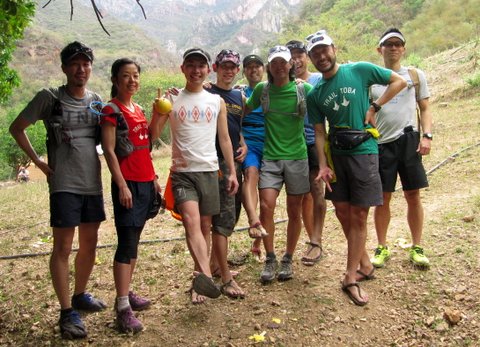
Japanese Runners in Luna Sandals
EM: Did you get to meet Manuel Luna, the man who taught Barefoot Ted how to make sandals?
TN: Yeah! Louis Escobar ran into Manuel in town. They were chatting and Manual asked him, "Where is the bald monkey?" Louis brought him to our hostel and he got to hang out with Barefoot Ted.
EM: Did you meet any of the runners from the first Born to Run race?
TN: One day, walking out of the market, I looked up and saw a familiar face. It was Arnulfo Quimare, the Tarahumara runner who won the first race ahead of Scott Jurek! That was a starstruck moment. I can't name two baseball players, but this was awesome. Another night, there was a sweat lodge ceremony. The guy who ran it was leading everyone in a meditation and prayer and every 20 minutes or so someone would appear to bring more hot logs for the steam. One time, it was Miguel Lara, who won the race the last two years! It was weird, that this guy was now acting as our servant. Billy ["Bonehead" from Born to Run] couldn't make it and Scott Jurek was in another country, but he came down there a few months ago for a memorial to Caballo.
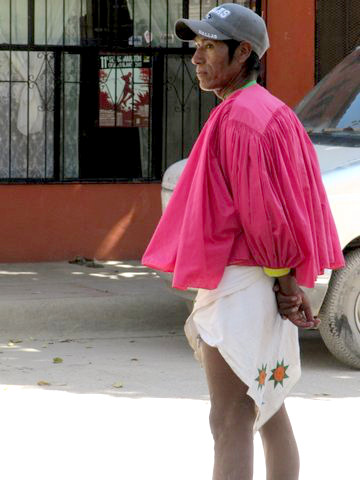
Arnulfo Quimare
EM: I heard there was a cap on how many outsiders could enter to race to keep it local and traditional. Was it intimidating to run with the Tarahumara on their own turf?
TN: No, it wasn't competitive at all. It felt so honoring, so exciting. The course is designed in a Y-shape, so you go out-and-back, out-and-back, out-and back. No matter where you place, you see the whole race before you. You see the race leaders again and again. I ran with Tarahumara women in their beautiful dresses and it was just unreal.
EM: Before the race, you mentioned you were excited to be part of the community captured in Born to Run. Did it live up to your expectations?
TN: Yeah, it surpassed them. The race was great and I'm excited to do it again, but it was really about the whole experience of being down there, being in the Los Mochis community and volunteering. It was several days of hanging around, meeting international runners from around the world. It was amazing eating meals at Mama Tita's restaurant. This year there was a big dinner celebration at the Tarahumara camp on Friday where they cooked cows and made soup. We got everyone out there.
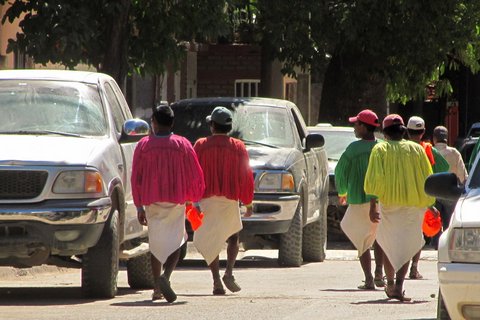
Urique and Tarahumara Runners in Los Mochis
EM: What's your favorite memory from the community?
TN: On Thursday, we hiked up to Los Alisos for a memorial to Caballo. There were probably 80 of us, and it was just beautiful up in the hills. There was a little farm up there and Caballo was good friends with the people who lived there. The son of the family he used to visit was living there now. He had lots of grapefruit trees and grew his own coffee.
For the memorial, Maria Walton, Caballo's girlfriend, gathered us in a circle near a big tree. She pulled out his ashes and passed them around so everyone could hold them. Then she read a true story Caballo wrote about the couple who used to live in that house. The story told about how they made love under that tree, then how the woman was buried under it when she died. Later, the man was buried under it, too. After the ashes made their way around the group, Maria spread them around the tree and burned a shirt from Los Mochis. It was amazing.
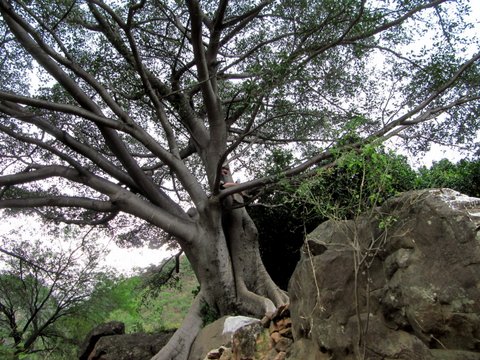
EM: That sounds like an incredible experience. So are you going back next year?
TN: Absolutely! This year, my goal was just to finish the race. Now, my goal is to learn to eat and drink properly while running and learn what my body can handle. I'd like to finish feeling better.
EM: Any plans for your next race?
TN: Not right now. At this point, it's more important for me to volunteer or pace. I've been rewarded so much by this race, it's time to give something back.
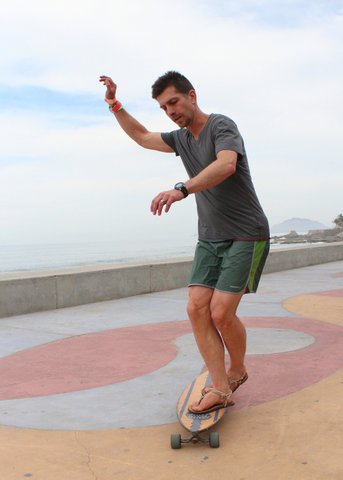
Thanks Tom! You can learn more about the Ultramarathon Caballo Blanco here.
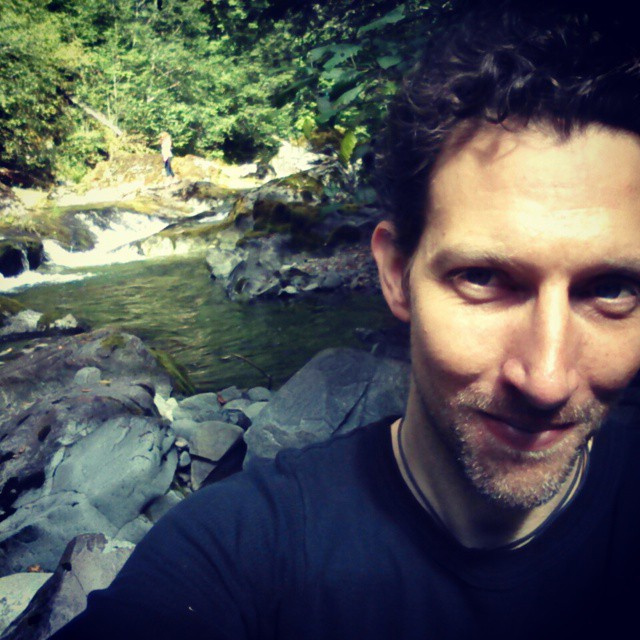
Martin is a lifelong runner who began wearing minimalist shoes over 10 years ago when he found they alleviated his chronic foot pain, which eventually disappeared completely. He further studied proper running form through a series of workshops taught by Correct Toes inventor, Dr. Ray McClanahan DPM. Martin has collaborated with several health care professionals to collect and share peer-reviewed studies that show the benefits of minimalist footwear. In his personal life, Martin loves living in the Pacific Northwest because it allows him to enjoy a variety of outdoor activities year-round, including hiking, cycling, rock climbing, surfing and snowboarding.

